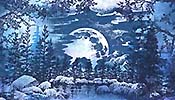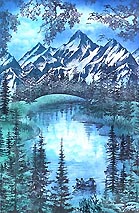

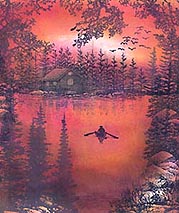

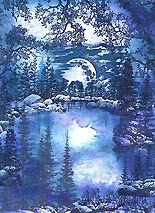
KN:Renee's gallery has been steadily
building up over the past couple years with terrific soulful scenes. What stands out in all of her
scenes, to my eye, is the atmosphere around her objects. Her scenes
seem to capture the essence of mist, haze, and reflected light.
Debussy once said that "Music is the space between the notes". With
Renee's scenes, perhaps, the soul of a scene is her implied space
between the objects.
I asked Renee if she would do an interview for her gallery. She replied with an introduction into her methods and stated: What can I say, but that working with the Stampscapes® line is unique. I find it challenging. Just when I think a completed scene is OK --nothing great or spectacular-- it's so cool when I give a stamped scene to someone and they tell me that "It looks like the place I vacationed at." or "I went fishing in an area that looked similar to this picture" or "This is neat -I like it! How's it done?"
My Thoughts & Methods by Renee Wendinger
The Stampscapes line of rubber stamps are great for creating unique works of nature art. What one constitutes with the stamps becomes your own technique. Stampscapes® are diverse, the images interlock and innovative scene. Creating a picture can be equally satisfying as well as frustrating. When frustration sets in I walk away from the project for awhile so I won't become discouraged. This usually does me some amount of good because when I come back to it I am able to take on a whole new perspective. The end result is often times gratifying.
Before I begin a scene I visualize. I mentally take note (file a picture in my mind, or sometimes I'll actually take a picture with my camera of a sight or an array of sky color if impressive) of nature all around me whether I'm outdoors walking or driving to and from areas. For instance overlooking a river, I may notice its bends and curves. I note how the trees are stacked or staggered, what objects are facade and behind, then use your imagination (yes you have one) with placing the Stampscapes® images. I may improvise a hill for a mountain, a cove may take the place of a river, and so on. Observe the colors in the sky at varying times of day and evening. A calm morning sky is quite different from a spectacular twilight sunset or a mystic nightfall.





I begin by choosing a 'key' stamp to build a scene with. Here is where I visualize my perspective, and use ones imagination (the one none of us think we have). I do quite a bit of experimenting, the results often times are satisfying. Sometimes the outcome gets a quick toss into the trash. One will never know how a scene takes format or color contrast unless one experiments.
I use matte or glossy card stock to achieve the best blend of colors. Dye-based media are applied to my work beginning with a light color, (example- Seashells "Ocean Aqua"). I overlap the color where needed with a complementary color, ("Aqua Mist") overlap again where needed with the next color value, and so on working from inside out. One can always go from light to dark, but cannot be reversed. I like to work with cool and warm colors for a nice contrast. When using cool colors --blue, green, purple-- I may add a touch of intermittent warmth using yellow, pink, oranges or reds.
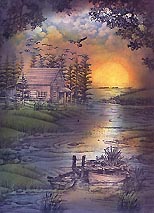
What I use to apply the colors with are twofold. Tonal Applicator -084E and a latex (wedge type --it must be latex for this smooth blender, will not fall apart, and can be washed over, and over again) make-up sponge. The Applicator allows colors to go on saturated; the sponge blends, and allows light touches of color. When using the sponge, I work it with the same way as the Applicator -the tap, tap, tap motion. A latex sponge has "bounce" so it "gives" as I blend the colors. To obtain a particular effect I keep in mind where I want my angle of light (white) source to reflect. I work around this also with the sponge giving shape and definition to light creating a realistic appearance.
KN: Renee, would you tell us a little background on yourself?
RW: I live in a country locale a few miles from the beautiful Minnesota River in southern Minnesota, where I enjoy the serenity of wide open spaces with my husband Lonnie. Our sons Lee and Terry, as well as daughter Jennifer are progressing as young adults away from home. I am the youngest of five children, and have always lived near the small town of Sleepy Eye (the name is mentioned numerous times on the television program "Little House on the Prairie" even though its locality is nearly 45 miles east of the shows setting of Walnut Grove).
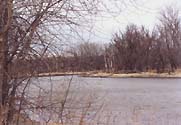
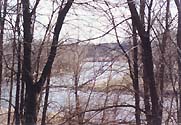
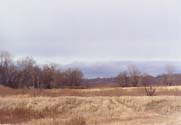
(Renee's photo studies that she states can be used to improvise with in creating a scene)
It is still a "prairie town" which inhabits 3500 people. The area is rich in farmland as well as Dakota history. The town was named for a great Indian chief -Ish-Tak-Ha-Ba- translated to English means Sleepy Eye. Our residence is within proximity of New Ulm a significant German town where I work seasonably when not working with my husband in agriculture. Minnesota --land of 10,000 (plus) lakes setting (especially the northern area) is comparable to many Stampscapes art stamps which may be the reason I like them so well. Aside from stamping, I am a history advocate of 'The Immigration/Orphan Train Experience' and adventure unique in America's history involving mass migrants of children.
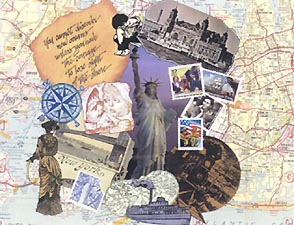
I am becoming a speaker on the subject which is very near, and dear to my heart. My mother Sophia was one of the children sent west on an Orphan Train from NYC, New York.
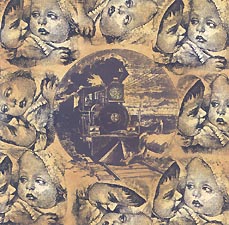
card collages: 1) Renee's personal summary of the Immigration/Orphan Experience. 2) monotone collage.
KN: What is your creative background?
RW: I have always loved art especially scenery paintings, but my sister Charlene is the talented one in the family (oils on Mi-Teintes paintings/sketch artist), everything she does is at liberty. A notable relative was once a great architect who had functioned successfully on many projects under the famous Frank Lloyd Wright. Artistic talent favored few in my lineage, which did not include me. I didn't possess an artistic bone in my body. (My mother disagrees of course --she'd find talent in all of her children).
KN: When did you start stamping, and how were you introduced to it?
RW: Seven years ago a nearby friend (Arlene) introduced me to the art of rubber stamping. She had taken a class, and immediately shared the 'magic' with me. I was intrigued, and from then on stamping became a creative outlet I enjoyed. Four years ago I attended a rubber stamp convention in my state with stamping friends. A demonstration taking place at the time caught my eye, and held my interest for the greater part of the day. The exhibit demonstrated Stampscapes art stamps using a dye-based medium on Kromecoat card stock. I was enthused immediately. Nature scenes are a favorite of mine. In fact I prefer all perspectives by nature/wildlife artistic painter Terry Redlin. He is my favorite artist.
KN: What is it you like about rubber stamping as a medium?
RW: The best fragment about rubber stamping is everyone can be an artist --I think! The stamps designed impressions formerly have achieved half the work. The other half is what one constitutes with the stamps into 'your own' personal creativity (perception, observation, appearance, atmosphere, & characteristic impression).
KN: What is the experience like for you during the process?
RW: For the most part I stamp on my own without obligation (though I've stamped periodically with friends Paula & Arlene throughout the years) when either time permits and/or I feel like 'playing'. Evening hours seem to be my relaxing time where I escape to my stamp room. I incorporate observation/music/mood when working on a project. I always stamp with music playing those good old rock and roll favorites. I'm sure the sounds don't set the thought process for my scenes, but rather move me into a creative mood.
KN: Your scenes seem to be about mood. I was wondering if you could expand on this? (touched on in introduction).
RW: When working on a Stampscapes scene I tend to respond to a very tranquil feeling inside leaving emotion progress into color choice. I'm inclined to observe my scenes as serene.
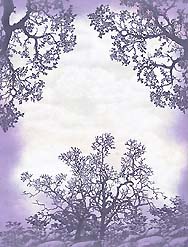
Other times, combined with realism, I may add something out of character attributed to animation for in all seriousness I like a sense of humor.
KN: Which sense do you feel is the basis for your scenes, and is one grounded more over the others?
RW: I look at my scenes as a concept of 'visually feeling' (if that makes any sense --no pun intended). It is like seeing a splendid array of sky color, which can bring a smile to my face creating the feeling of peaceful moments. I hope to achieve a sense of peacefulness in my scenes.
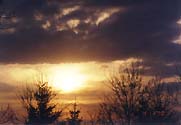
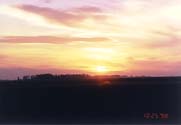
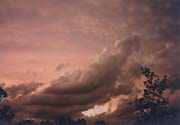
(Renee's photographic sky studies)
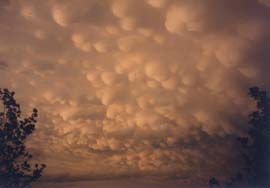
(photo taken 06/30/94 from Renee's house: Cumulonimbus "A once in a lifetime view. Golf ball sized hail fell, funnel clouds and continuous lightning through these low dropping clouds."
KN: Do you see your work grounded in a certain aesthetic?
RW: I'm not quite sure where to pinpoint or if I have a basis for creativity, but it tends to come from within. It may be complex to feeling an emotion or sentiment inside. I have never taken art classes, and do not assume absolute knowledge on the subject. I just do my own thing. When I'm pleased with the outcome of a scene, and someone on the receiving end is equally pleased --that's great!
KN: Is there an overall statement that your scenes say to you, or that you say through them?
RW: I would have to say that I speak through my scenes conveying a quiet calm. Life is busy, but one should take time to look at the wonders of nature. Nature gives to every time, and season so beauty of its own. Observe it, protect it, and appreciate it!
KN Note: I would like to thank Renee for sharing her thoughts and ideas with us. I certainly feel she's an artist that's truly capable of capturing the essence of the natural wonders in her evocative visuals. Mood/Emotion as the foundation for the arrangements really set the tone in these works. Great stuff Renee! ~K
